Bugaku |
Written as two ideograms (kanji):

 bu, as in kabuki - meaning 'dance'
bu, as in kabuki - meaning 'dance'
 gaku, familiar from Nogaku, Kyogen, etc, meaning entertainment.
gaku, familiar from Nogaku, Kyogen, etc, meaning entertainment.
Background
Bugaku is a style of dance associated with traditional court music known as Gagaku.
Already in existence by the beginning of the Heian period (794-1185), it represents one of the oldest forms of court entertainment.
Plots are typically abstract, focussing on a single significant episode out of a larger storyline.
The action is organized according to the philosophy of jo-ha-kyu
(clear introduction, development, rapid ending), familiar from the study of Noh.
|
The Space
The stage as a whole is called the takabutai.
The performance space or shiki butai (1) is flanked by a red railing or koran (2).
There is a set of stairs (upstage center) called the tojo kaidan (3).
These are used for entrances and exits. A corresponding set of stairs at downstage center are called the shomen kaidan (4).
They lead to the audience seating (kyakuseki), and are similar to those of the Noh stage.
The orchestra area (5) or kan-kata is backstage right.
There is a corresponding kan-kata at backstage right, and the musicians will shift place according to the style of Bugaku. |
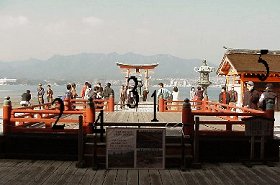 |
Categories
Gagaku is usually divided into three main categories:
1)Togaku is derived primarily from Chinese sources (Tang period, 7th to 10th century).
About 100 pieces in the musical repertoire are of this type.
Variations (Tora-gaku and Rin-yu-gaku) reflect influences from even further afield (India and SE Asia).
2)Komagaku or Korai-gaku is associated with the ancient provinces of the Korean Penninsula (Silla, Paekche, Korai, and so on).
3) Indigenous styles - music to accompany Shinto rituals, as well as yamato uta, azuma asobi, kume uta and (later) folk songs. |
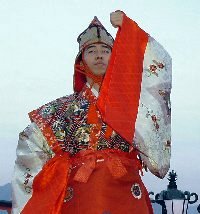 |
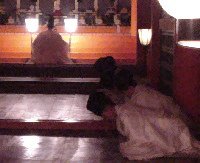 |
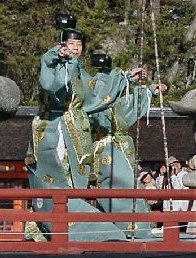 |
Chinese-influenced Togaku Bugaku are known as 'dances of the Left' (Saho no mai).
Costumes are usually red. Komagaku (Korean) Bugaku are the 'dances of the Right' (Uho samai no mai, or simply u mai).
Costumes are blue or green, in keeping with court dress in the Heian period (794-1185).
In some Shrine performances, the distinction between left and right is literally spatial
- with entrances and exits changing sides to match the pedigree of the music.
Dances set to indigenous Gagaku are usually referred to as mikagura rather than Bugaku. Actors usually wear the white robes of a Shinto priest. |
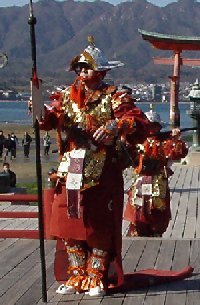 |
A second division is based on whether the dance theme is military (bu no mai)
or civilian (bun no mai). |
A third distinction is based on tempo.
Hira mai are slow dances associated with the Chinese aristocracy.
Hashiri mai are fast, vigorous pieces for a solo, masked actor. |
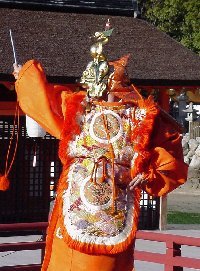 |
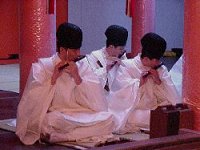 |
Instruments
The various categories of Bugaku are accompanied using different sets of instruments.
The hichiriki or reed pipe has several variations - ryuteki for (Chinese)
Togaku, Komabue for Komagaku, and the Kagurabue for Shinto music.
The sho is a mouth organ with 17 pipes. It figures prominently in Dances of the Left.
The shoko is a bronze gong, used to keep the tempo. Other percussion instruments
include the san no tsuzumi (a 1-stick drum) and the kakko (a small 2-stick drum used in Togaku).
Clappers are also sometimes used. |
Links
A good overview of Bugaku and Gagaku is available from
Colorado College.
The Virtual Museum
of Traditional Japanese Arts is a source for information on
play categories and provides a few synopses. And there are a number of private
pages including
Karl's
site, with links to more information on Japanese traditional music.
References
Gagaku in Kodansha Encyclopedia of Japan VIII (1983). Tokyo: Kodansha Ltd., pp 1&2.
O'Neill, P. (1958). Early No Drama: It's Background, Character and Development 1300-1450. Westport: Greenwood Press, Publishers.
Kenny, D. (1974) On Stage in Japan: An Invitation to Traditional Japanese Theatre. Tokyo: Shufunotomo Co. Ltd. |
|






